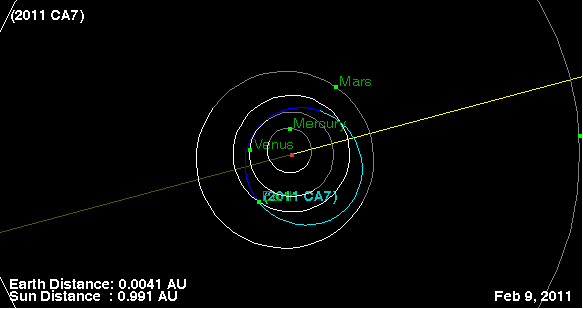Car-Size Asteroid to Pass Close by Earth Wednesday

An asteroid about the size of a car will pass close by Earth Wednesday (Feb. 9), the second space rock in five days to fly near – but pose no threat of hitting – our planet.
The asteroid is called 2011 CA7 and will fly within 64,300 miles (103,480 kilometers) of Earth tomorrow, according to an alert from NASA's Asteroid Watch program. It is about 9 1/2 feet across (nearly 3 meters) and was discovered by astronomers earlier this month.
The asteroid will make its closest pass by Earth at around 2:25 p.m. EST (1925 GMT), according to the small-body database overseen by NASA's Jet Propulsion Laboratory in Pasadena, Calif.
On Feb. 4, the asteroid 2011 CQ 1 sailed within 3,400 miles (5471 km) of Earth during its brief encounter. That asteroid was about 4 feet (1.3 meters) wide, less than half the size of 2011 CA7.
For comparison, the distance between Earth and the moon is about 238,900 miles (384,402 km).
Like Friday's asteroid flyby, 2011 CA7 poses no threat of impacting Earth. Even if it did enter Earth's atmosphere, the space rock would never survive the fiery trip to the surface. It's so small, it would likely break apart or incinerate on the way down.
Scientists say asteroids the size of 2011 CA7 and 2011 CQ 1 regularly fly close by Earth, but their small size makes them hard to spot.
Get the Space.com Newsletter
Breaking space news, the latest updates on rocket launches, skywatching events and more!
"It's predicted that tiny space rocks pass between Earth and moon almost daily but are too small to be detected and pose very little threat," NASA's asteroid-tracking team wrote in a Twitter message Monday (Feb. 7).
NASA and other dedicated astronomers routinely track asteroids and comets as part of a near-Earth observation program designed to seek out potentially hazardous objects that could pose an impact risk to Earth.
Potentially hazardous asteroids are space rocks about 490 feet (nearly 150 meters) wide or larger that fly too close to Earth for comfort, NASA officials have said. The space agency's Near-Earth Object office at JPL coordinates efforts to detect, track and characterize the threats posed by asteroids and comets.
You can follow SPACE.com Managing Editor Tariq Malik on Twitter @tariqjmalik.
Join our Space Forums to keep talking space on the latest missions, night sky and more! And if you have a news tip, correction or comment, let us know at: community@space.com.

Tariq is the Editor-in-Chief of Space.com and joined the team in 2001, first as an intern and staff writer, and later as an editor. He covers human spaceflight, exploration and space science, as well as skywatching and entertainment. He became Space.com's Managing Editor in 2009 and Editor-in-Chief in 2019. Before joining Space.com, Tariq was a staff reporter for The Los Angeles Times covering education and city beats in La Habra, Fullerton and Huntington Beach. In October 2022, Tariq received the Harry Kolcum Award for excellence in space reporting from the National Space Club Florida Committee. He is also an Eagle Scout (yes, he has the Space Exploration merit badge) and went to Space Camp four times as a kid and a fifth time as an adult. He has journalism degrees from the University of Southern California and New York University. You can find Tariq at Space.com and as the co-host to the This Week In Space podcast with space historian Rod Pyle on the TWiT network. To see his latest project, you can follow Tariq on Twitter @tariqjmalik.












